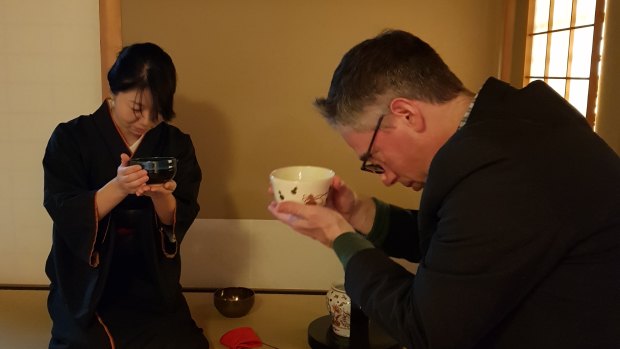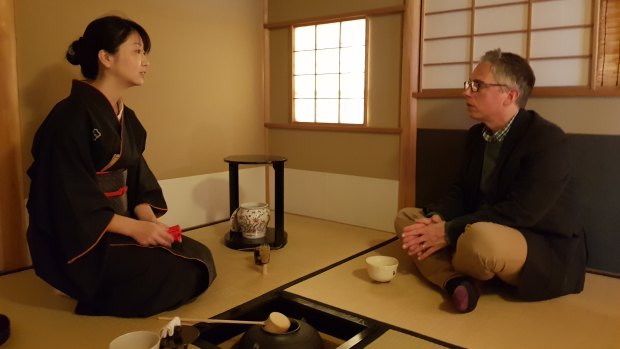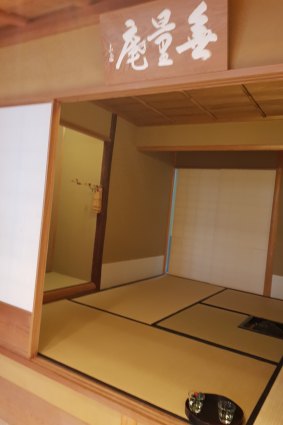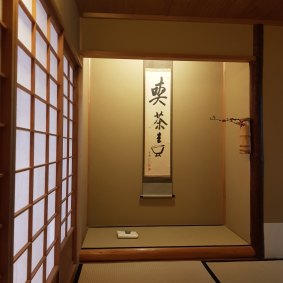Kyoto: In a slick retail building, the location of the tea ceremony appeared to embrace Japan’s contradiction. The ritual dated back to the 1400s, but today, this event would take place within a tidy, glass-walled setting.

The Japanese tea ceremony is rich with ritual and meaning.Credit: The Age
Drinking tea was something I had been converted to only recently and only occasionally. Seeing the elaborate Japanese ceremony built around it was a logical stop on a tour of Kyoto.
My guide Oka and I took the elevator up, continuing our conversation from the car about how technology made it harder than ever to shut out the incessant distraction.
The hush of the interior was welcome after the bustle of the city streets.
We were waved towards the back by a woman in a kimono, who gave me instructions on how to enter the room, called a chashitsu, through a special hatch door.

The reporter is guided through the tea ceremony or chanoyu in Kyoto.Credit: The Age
Even opening the hatch, called a nijiriguchi, was ritualised, by holding a left hand firmly to shift the panel – but only midway – at which point, the right hand completes the action.
Entering the narrow passage essentially required a bow upon arrival.
Looking up, I found a sparse room laid out with tatami mats and a kettle inset in the floor. In the corner was an alcove, with a spare flower in a vase, and importantly, an unfurled scroll with a message.

The chashitsu, where the tea ceremony takes place.Credit: The Age
I waited. Soon another woman, also in a kimono, padded in and sat across from me. She was the teishu, who would lead the ceremony.
Bowing and the settling into a kneel, she took the lid off the kettle and gestured to it, the sound of boiling water hissing and popping quietly from its opening. “Listen to the water; like the sound of a forest floor,” she said.
Soon she began the cleaning of the tea bowl, then the preparation of the tea, with a series of steady, controlled hand movements.
Because of the exacting placement of every utensil, the ceremony involves total attention, which forms a kind of moving meditation. Also known as the Way of the Tea, the ritual event is closely associated with Zen Buddhism.
Unlike high tea, or Devonshire tea, or even Texas tea, the Japanese tea ceremony is equal parts honour, hospitality, ritual and mental cleansing.
Samurai once gathered at such ceremonies. With everyone seated closely in the chashitsu, the experience conveyed trust, except in the occasional case when a samurai was poisoned. (But that’s just history.)
The teishu mixed the matcha, the powered green tea grown only in shade, and brought it to a temperature by adding cool water to the boiling cupful.
Balance in everything.

"Drink the tea": the scroll on the wall.Credit: The Age
The hush filled the small room as she whisked the tea until it made a frothy, vivid green.
She handed me the bowl. Matcha tea has a mild, almost milky flavour.
Over the tea, I learnt that the teishu had studied the tea ceremony for some time, and could study spend her entire life in a search for perfection.
The observation that other cultures in Asia seek beauty by adding colours and textures to a picture, while in Japan they seek it by taking elements away, came to mind.
Time is an element of the Way of the Tea, too. No two moments and therefore no two tea ceremonies are the same. There was a term for this: ichi-go-ichie.
Each moment, only once; this is part of the philosophy linked to the ritual.
In the corner, an unfurled scroll held a message in Japanese calligraphy. What does it say? I asked.
“Drink the tea”, she said, which seemed almost too obvious.
After a moment, she elaborated: “It’s the answer to the question. ‘Master, how do I achieve enlightenment?' Drink the tea.”
Later, I was told the same symbol could mean taste, or even, experience the tea.
But in that moment, sitting on the tatami, with a bowl of tea before me, I forget the noise of the street, or its bustle, or even that there exists a city outside.
Chris Zappone travelled to Japan as a guest of the government.